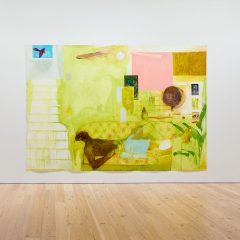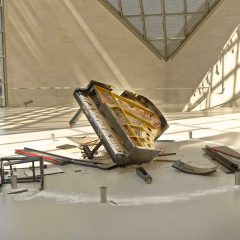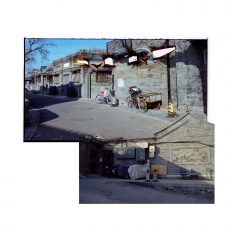Post by Judith Stein
To get to The Edges of the World, Brazilian artist Ernesto Neto’s extraordinary installation at London’s Hayward Gallery, you first have to find the Hayward. It is situated above street level in the cultural complex known as the South Bank Centre. You might approach it from the Thames walkway, mounting one of three hulking stairways gamely painted yellow, blue or red, to arrive at the Hayward’s front door. Better yet, walk across Waterloo Bridge heading south and step down directly into its entrance courtyard.
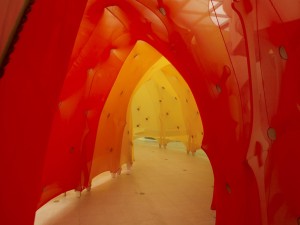
Neto was four years old in 1968, the year London’s Hayward Gallery opened. The Brutalist aesthetic then dominated British architecture, and the Hayward’s exposed concrete construction was the epitome of this minimalist style of the Sixties. Forthright and unadorned, the Hayward promised its patrons to “tell it like it is,” as the Neville Brothers crooned, and proclaimed with Frank Stella, “What you see is what you see.”
Neto grew up to create sculpture that is the polar opposite of Brutalism. In his hands, edges are soft, walls translucent, and flights of fancy encouraged at every turn. The first—and unlabeled—aspect of The Edges of the World that greets visitors is Neto’s luxuriant leaf decals that adorn a section of the Hayward’s cheery glass front, remodeled in 2003. The same laser-cut patterns are also inside the foyer, here as perforations on a high wooden screen that shields a child-scaled table and stools. They are all constructed of slotted wood cutouts of the motif.
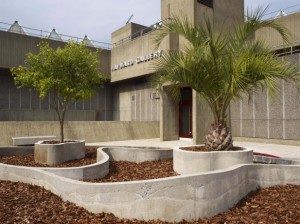
Dan Graham’s permanently installed glass pavilion is accessible from this lobby, but wait to see it until after you’ve trekked to the main installation of The Edges of the World. As well, save for later a visit to The New Décor, the Hayward’s eye-catching show of work by 36 artists who take interior design as a point of departure. You’ll need to pass through it on your way to the Neto.
Follow the signage up the concrete staircase whose walls bear the impression of the wood planks used to construct them. An opening in a dropped ceiling signals the periphery of Neto’s domain of organic curves and filtered light. The flanking stair walls are “upholstered” with gossamer fabric weighted down with pebbles.
Visitors find themselves in an impromptu performance-in-progress when they step up into The Edges of the World. I felt a little like Alice, also Dorothy, when entering Neto’s alternative universe. All around, the adults and children who arrived before me were climbing Neto-built viewing stations, or banging a kettle drum, or exploring wooden books at what Neto calls “the library mind table.”
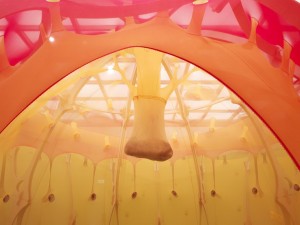
The installation spills out into all three of the Hayward’s rarely utilized outdoor sculpture courts. Each houses an interactive environment framed against the background of the London skyline. Here are the veritable edges of Neto’s sphere, the amorphous seam where his conceit ends and “reality” begins. In one, a diminutive stool companionably accompanies a four-ton, seemingly teeter-tottering sculpture. Neto constructed both the viewing perch and the towering monument to “unstable verticality” to use his description, by simply slotting together his favored leaf-shaped segments, here made of chocolate-patinated Cor-ten steel.
In another of the Hayward’s open air spaces, Neto created “walking to the future,” an oasis of low loop-de-loop concrete boundaries that encapsule a potted tropical palm and a temperate hawthorn. Visitors can circumnavigate its narrow border à la tightrope artist Philippe Petit, as they take in a panorama of the Houses of Parliament, the London Eye, and the arched shed of Royal Festival Hall.
To Richard Serra, site-specific art is successful when it becomes part of the site and restructures it both conceptually and perceptually. By all these measures, The Edges of the World is a stunning success. The Hayward’s outer casing was far from my mind as I stroked a tonsil laden with powdered lavender, cumin and cloves that forms the pendulous centerpiece of one translucent pavilion. Like all of Neto’s constructions in The Edges of the World except those in steel, it is made of sheer, stretchy fabric pulled across a skeleton of interlocking, bone-like forms that were laser-cut out of wood.
In 1994, Mona Hatoum created Corps étranger, an installation with jolting video footage that brought viewers inside her body’s various orifices. At the Hayward, Neto invites us to imagine what it might be like to enter our own bodies as we step inside a convoluted, intestine-like passage. He eschews the visceral in favor of the sensual by using sheer fabric walls that gradually change colors in the order of the spectrum. Periscopes for your hands abound, allowed you to poke through to adjacent areas. Loopy pockets of dried chamomile line the way in places; transit time, as in life, is variable, depending how entranced you are by the journey.
On a good day, the light at the end of this tunnel is the sun. The pathway ends at the threshold of the largest of the Hayward’s three outdoor sculpture terraces. Here Neto provides us with what he calls a “lake,” a generously-sized, inflated hot tub of his own design. When booked in advance for no additional fee, you can take a dip in this fanciful body of water, and change into your suit in Neto-constructed “his” and “her” booths with Neto-made lockers.
To exit, you retrace your path. On your way down the Hayward’s main staircase, male and female visitors alike should pop into the men’s lavatory, where as part of The New Décor, the collaborative team of Elmgreen & Dragset have installed one of their Powerless Structures, an ongoing series of mischievous sculptures. Once you reach ground level, take in the rest of the show.
Neto’s site-specific installation The Edges of the World sprawls sensually within the Hayward’s Brutalist shell. Unlike any other show I’ve ever seen there, it re-ordered my experience of the building as powerfully as did the daisy that a hippy inserted into a rifle barrel, temporarily transforming a gun into a flower holder back in the Sixties.
–Judith Stein is a Philadelphia-based writer at work on a biography of the late art dealer Dick Bellamy, “the eye of the sixties.”


